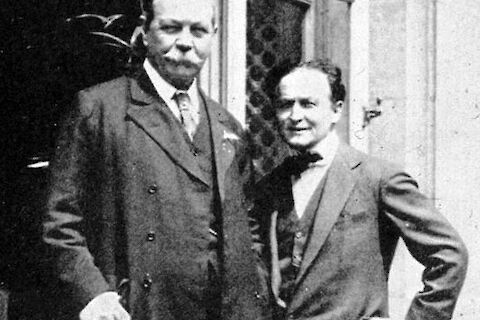

Harry Houdini and Sir Arthur Conan Doyle
Harry Houdini was a well-known magician who also moonlighted as a spiritualist debunker. Although he continued to perform magic, later in life, he was dedicated to exposing frauds within the spiritualist community. Sir Arthur Conan Doyle was most famous for authoring the Sherlock Holmes series. He also had a strong interest in spiritualism and was a member of the Society for Physical Research. A keen interest in the paranormal brought this unlikely pair together, and also tore them apart.
Houdini very much wanted to believe in the paranormal, especially after the death of his mother who he was very close to. As someone who had performed fake seances in his younger days to make ends meet (something he was said to be ashamed of), he was extremely hard to convince. During a time when the world was grieving after many deaths caused by war and the great depression, people were spending their hard-earned money engaging in mediums to contact their loved ones for a sense of closure. Houdini made it his mission to expose all of those that he was able to prove were not genuine. He would often attend seances dressed in disguise, and once he worked out their trickery, he would stand up and throw off his costume and proclaim 'I am Houdini, and you are a fraud'. He would show images of the mediums at his performances where he named and shamed them and revealed how they deceived their clients. As a magician, people themselves thought that perhaps Houdini had supernatural powers, and was quite surprised at how strongly he seemed to oppose spiritualism. It wasn't that he opposed it, it was more that no one was able to convince him that they possessed such powers. Houdini in fact, very much wanted to believe.
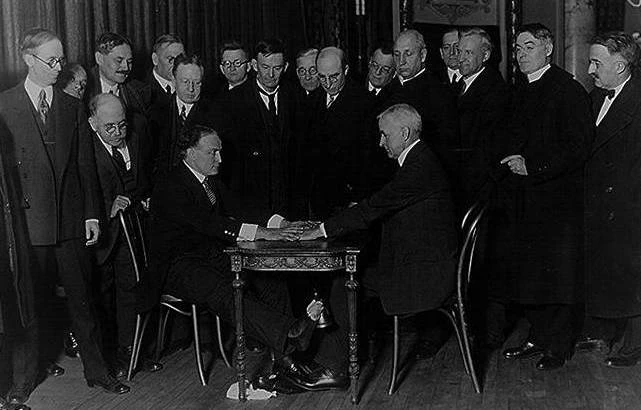
Image source: theovertake.com
Sir Arthur Conan Doyle who was a medical doctor but most famous for his work as an author, always had an interest in the paranormal and spiritualism. People often associate his interest in the paranormal with the death of his son, however, he was involved within the paranormal for years prior to his death in 1918. In 1889, he was one of the founding members of the Hampshire Society for Psychical Research and went onto join the Society for Psychical Research based in London in 1893. If you thought that writing about a detective would make him more of a skeptic, you would be wrong. Doyle was very much convinced by many spiritualists. He wrote a book in 1922 called 'The Coming of Fairies' where he proclaimed to believe in the infamous Cottingley Fairies to be real along with the theory on nature and fairies. The photos were decades later admitted as faked. Doyle also threw his support behind defamed spirit photographer William Hope in 1922 after famous paranormal investigator Harry Price proclaimed he was a fraud. Doyle went on to lead a mass resignation of members from the Society of Psychical Research claiming the institution was against spiritualism.
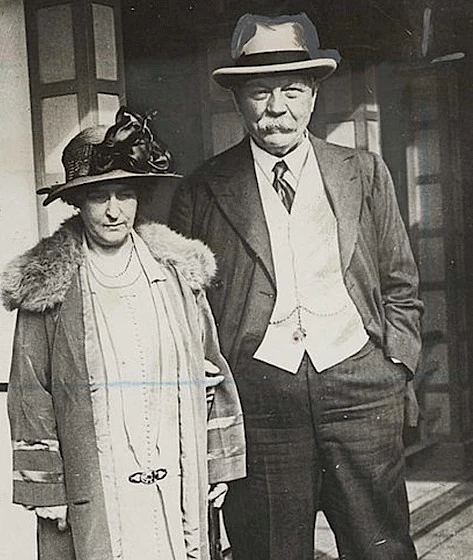
Doyle with his wife Jean Image Source Curosity.com
Before meeting in person in 1920, Houdini sent Doyle one of his books 'The unmasking of Robert Houdin' which exposed the methods of the mediums that Doyle passionately defended. Not taking offense, he believed that Houdini was fighting the good fight and was working on the side of spiritualism and just weeding out the frauds. For years they exchanged letters and mutual admiration. Houdini felt that Doyle was too quick to jump to conclusions, and always seemed to believe what he sees. Houdini once demonstrated how a medium performs slate-writing. Doyle was convinced that Houdini had special powers, however, he wanted his friend to understand it was all just a trick.
Sir Arthur, I have devoted a lot of time and thought to this illusion ... I won’t tell you how it was done, but I can assure you it was pure trickery. I did it by perfectly normal means. I devised it to show you what can be done along these lines. Now, I beg of you, Sir Arthur, do not jump to the conclusion that certain things you see are necessarily “supernatural,” or the work of “spirits,” just because you cannot explain them....
Harry Houdini
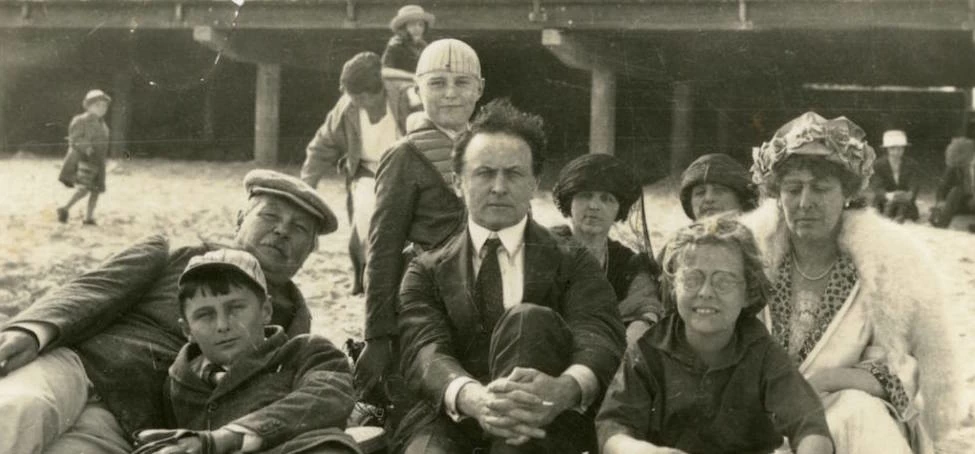
Doyle on holiday with his family and Harry Houdini in Atlantic City, 1922 Source: theovertake.com
In 1922, while on holiday together, Doyle's wife Jean who was a psychic medium offered to give Houdini a special private seance in which he would be able to make contact with his mother, something he had longed for. During an automatic writing session, Jean wrote out a well-written letter in English underneath the symbol of a Cross. Doyle claimed that Houdini seemed to be moved by this touching communication. Houdini was not convinced that Jean's letter was from his mother. His Mother spoke very poor English and the letter was written perfectly - grammar and all. Secondly, it was written under the drawn symbol of a cross. His mother was Jewish. Third, it was the day of her birthday something that was not mentioned at all in the letter. Doyle wrote publicly to proclaim that Houdini had been visited by his Mother's spirit. It was something that Houdini was willing to let go of for the sake of his friendship. Doyle was later surprised to find that Houdini publicly claimed later in a press interview that he had never seen any evidence of a genuine medium that upset his wife Jean. While through correspondence they put the incident behind them, their relationship would never recover.
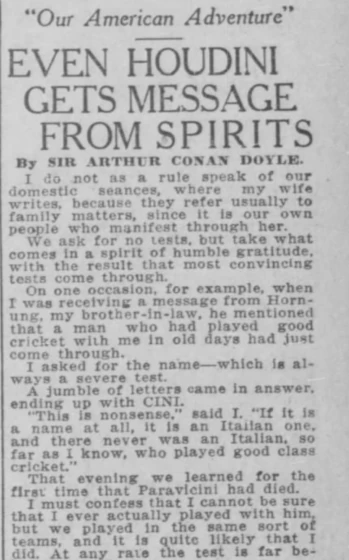
30th November 1922 Source: Newspapers.com
The nail in the coffin came when medium Mina Crandon (also known as Margery Crandon) was famously exposed by Houdini, a person that Doyle advocated for. She was submitted as a candidate for Scientific American magazine's challenge for a cash prize for a medium who could prove that they had some sort of supernatural ability. The majority of the panel judging her abilities were convinced, however, the final member of the panel - Houdini was not. After he figured out her method of deception, he built a special box she was asked to sit in to perform the seance. The Crandon's claimed that Houdini tampered with the bell and planted a ruler in the box something which he strongly denied. Ultimately, she was not able to perform her seance and was stripped of the prize. This also marked the end of the friendship between Doyle and Houdini.
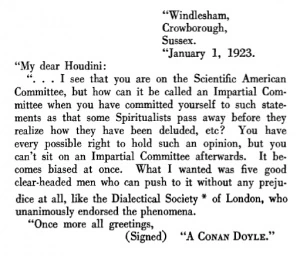
Source: arthur-conan-doyle.com
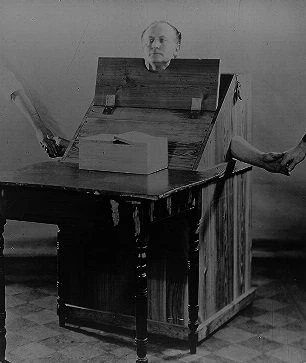
Image Source: Houdini Tribute
Houdini continued in his pursuit to expose spiritualists until his death in 1926 even offering a challenge to pay $10000 to anyone who could convince him they had genuine abilities. He never had to pay the sum as no one was able to fool him. Doyle went on supporting spiritualism until his death in 1930.

Image Source: Houdini Tribute
After Houdini's death in 1926, putting pride and the feud aside, Doyle wrote to Houdini's wife Bess
I am sure that, with strength of character (and possibly his desire to make reparation), he will come back.
In return, Bess sent to Doyle a collection of Doyle's father's artwork that Houdini had required at auction. Doyle wrote back to Bess
The book arrived and filled me with surprise... It really seems like a series of miracles–first that it should exist still, then that it should cross the Atlantic, and finally that it should come back home. I accept it as a peace-offering from your husband, and I thank him as well as you.
Doyle had the last say in the feud penning a two-part series in the Strand Newspaper called the Houdini, the enigma. It was published a year after Houdini died.
It is a curious fact that neither my wife nor I knew what was in the mother's letter until I read it in his book. It was written so swiftly that the medium could at best only have a very vague idea of its purport, while I never even glanced at it. Now that I read it, it seems to me to be a very beautiful letter, full of love and of longing. As I have explained, the thought are given and are largely translated by the medium. Therefore, there are some sentences in which I can recognize my wife's style of expression, but the greater part of it is far more fervid — one might almost say more Oriental — than anything I have known my wife do. Here is an extract:—
"Oh, my darling, my darling, thank God at last I am through. I've tried, oh, so often. Now I am happy. Of course, I want to talk to my boy, my own beloved boy... My only shadow has been that my beloved one has not known how often I have been with him all the while... I want him only to know that — that — I have bridged the gulf — that is what I wanted — oh, so much. Now I can rest in peace."
It was a long and very moving message and bore every internal sign of being genuine. There is no question at all in my mind that Houdini was greatly shaken at the time and for some days afterwards. His objections were all afterthoughts in order to save the situation.Houdini the enigma - Sir Arthur Conan Doyle
The Strand 1927 (Published a year after Houdini's death in 1926)
If you enjoy LLIFS, consider buying me a book (otherwise known as buy me a coffee but I don't drink coffee and I LOVE books). Your donation helps to fund the LLIFS website so everyone can continue to access great paranormal content and resources for FREE!

Top pages with similar subjects
Don't forget to follow the Facebook page for regular updates
Join the mailing list to receive weekly updates of NEW articles. Never miss an article again!
Buy the latest and past issues Haunted Magazine
Check out the books written by LLIFS